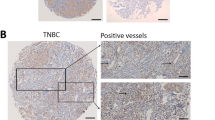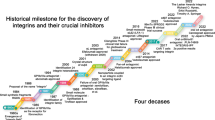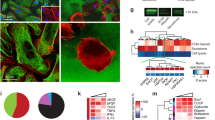Abstract
Integrin/cytokine receptor interaction provides permissive signals leading to neoangiogenesis, and integrins are crucial for differentiation of endothelial progenitor cells (EPCs). It is known that the inflammatory interleukin-3 (IL-3), released in the tumoral microenvironment, contributes to both angiogenesis and vasculogenic processes. Herein, we generated IL-3 receptor beta common (IL-3Rβc) extracellular domain-derived fusion proteins (Fc) to elucidate the molecular mechanisms regulating these processes. Three different Fc were generated, containing the entire extracellular domain of IL-3Rβc (Fc1.4), a fragment corresponding to domains 1–3 (Fc1.3) and a fragment corresponding to domain 4 (Fc4), respectively. The ability of the fusion proteins to interfere with IL-3Rβc/β1 integrin interaction was assessed on endothelial cells (ECs), EPCs and murine-derived ECs. Pull-down experiments showed that Fc1.4 and Fc4 fusion proteins specifically interacted with β1 integrin. Fc4 and Fc1.4 fragments prevented IL-3-mediated EPC expansion, arterial morphogenesis and tumour-derived EC migration, without affecting cell adhesion. Fc4 in vivo inhibited the IL-3-mediated vasculogenic process, as well as inflammatory and tumour vascular growth. In conclusion, these data identify the β1 integrin-interacting domain in the juxta-membrane IL-3Rβc extracellular domain, and provide the rational for targeting this interaction to impair vascular growth.
This is a preview of subscription content, access via your institution
Access options
Subscribe to this journal
Receive 50 print issues and online access
$259.00 per year
only $5.18 per issue
Buy this article
- Purchase on Springer Link
- Instant access to full article PDF
Prices may be subject to local taxes which are calculated during checkout






Similar content being viewed by others
References
Ahn GO, Brown JM . (2009). Role of endothelial progenitors and other bone marrow-derived cells in the development of the tumor vasculature. Angiogenesis 12: 159–164.
Asahara T, Murohara T, Sullivan A, Silver M, van der Zee R, Li T et al. (1997). Isolation of putative progenitor endothelial cells for angiogenesis. Science 275: 964–967.
Bazan JF . (1990). Haemopoietic receptors and helical cytokines. Immunol Today 11: 350–354.
Bellik L, Ledda F, Parenti A . (2005). Morphological and phenotypical characterization of human endothelial progenitor cells in an early stage of differentiation. FEBS Lett 579: 2731–2736.
Biancone L, Stamenkovic I, Cantaluppi V, Boccellino M, De Martino A, Bussolino F et al. (1999). Expression of L-selectin ligands by transformed endothelial cells enhances T cell-mediated rejection. J Immunol 162: 5263–5269.
Brizzi MF, Battaglia E, Montrucchio G, Dentelli P, Del Sorbo L, Garbarino G et al. (1999). Thrombopoietin stimulates endothelial cell motility and neoangiogenesis by a platelet-activating factor-dependent mechanism. Circ Res 84: 785–796.
Buitenhuis M, Coffer PJ, Koenderman L . (2004). Signal transducer and activator of transcription 5 (STAT5). Int J Biochem Cell Biol 36: 2120–2124.
Bussolati B, Deambrosis I, Russo S, Deregibus MC, Camussi G . (2003). Altered angiogenesis and survival in human tumor-derived endothelial cells. FASEB J 17: 1159–1161.
Carr PD, Gustin SE, Church AP, Murphy JM, Ford SC, Mann DA et al. (2001). Structure of the complete extracellular domain of the common beta subunit of the human GM-CSF, IL-3, and IL-5 receptors reveals a novel dimer configuration. Cell 104: 291–300.
De Palma M, Venneri MA, Galli R, Sergi Sergi L, Politi LS, Sampaolesi M et al. (2005). Tie2 identifies a hematopoietic lineage of proangiogenic monocytes required for tumor vessel formation and a mesenchymal population of pericyte progenitors. Cancer Cell 8: 211–226.
Defilippi P, Rosso A, Dentelli P, Calvi C, Garbarino G, Tarone G et al. (2005). {Beta}1 Integrin and IL-3R coordinately regulate STAT5 activation and anchorage-dependent proliferation. J Cell Biol 168: 1099–1108.
Dentelli P, Del Sorbo L, Rosso A, Molinar A, Garbarino G, Camussi G et al. (1999). Human IL-3 stimulates endothelial cell motility and promotes in vivo new vessel formation. J Immunol 15: 2151–2159.
Dentelli P, Rosso A, Balsamo A, Colmenares Benedetto S, Zeoli A et al. (2007). C-KIT, by interacting with the membrane-bound ligand, recruits endothelial progenitor cells to inflamed endothelium. Blood 109: 4264–4271.
Dentelli P, Rosso A, Calvi C, Ghiringhello B, Garbarino G, Camussi G et al. (2004). IL-3 affects endothelial cell-mediated smooth muscle cell recruitment by increasing TGF beta activity: potential role in tumor vessel stabilization. Oncogene 23: 1681–1692.
Dentelli P, Rosso A, Garbarino G, Calvi C, Lombard E, Di Stefano P et al. (2005). The interaction between KDR and interleukin-3 receptor (IL-3R) beta common modulates tumor neovascularization. Oncogene 24: 6394–6405.
Desgrosellier JS, Cheresh DA . (2010). Integrins in cancer: biological implications and therapeutic opportunities. Nat Rev Cancer 10: 9–22.
Folkman J . (2006). Angiogenesis. Annu Rev Med 57: 1–18.
Furuya M, Yonemitsu Y, Aoki I . (2009). III. Angiogenesis: complexity of tumor vasculature and microenvironment. Curr Pharm Des 15: 1854–1867.
Gao D, Nolan D, McDonnell K, Vahdat L, Benezra R, Altorki N et al. (2009). Bone marrow-derived endothelial progenitor cells contribute to the angiogenic switch in tumor growth and metastatic progression. Biochim Biophys Acta 1796: 33–40.
Gao D, Nolan DJ, Mellick AS, Bambino K, McDonnell K, Mittal V . (2008). Endothelial progenitor cells control the angiogenic switch in mouse lung metastasis. Science 319: 195–198.
Giancotti FG, Tarone G . (2003). Positional control of cell fate through joint integrin/receptor protein kinase signaling. Annu Rev Cell Dev Biol 19: 173–206.
Giraudo E, Arese M, Toniatti C, Strasly M, Primo L, Mantovani A et al. (1996). IL-6 is an in vitro and in vivo autocrine growth factor for middle T antigen-transformed endothelial cells. J Immunol 157: 2618–2623.
Gröger M, Loewe R, Holnthoner W, Embacher R, Pillinger M, Herron GS et al. (2004). IL-3 induces expression of lymphatic markers Prox-1 and podoplanin in human endothelial cells. J Immunol 173: 7161–7169.
Guo W, Giancotti FG . (2004). Integrin signalling during tumour progression. Nat Rev Mol Cell Biol 5: 816–826.
Hutchings H, Ortega N, Plouët J . (2003). Extracellular matrix-bound vascular endothelial growth factor promotes endothelial cell adhesion, migration, and survival through integrin ligation. FASEB J 17: 1520–1522.
Kibbey MC, Grant DS, Klieinman HK . (1992). Role of the SIKVAV site of laminin in promotion of angiogenesis and tumor growth: an in vivo Matrigel model. J Natl Cancer Inst 84: 1633.
Lyden D, Hattori K, Dias S, Costa C, Blaikie P, Butros L et al. (2001). Impaired recruitment of bone-marrow-derived endothelial and hematopoietic precursor cells blocks tumor angiogenesis and growth. Nat Med 7: 1194–1201.
Mäkinen T, Adams RH, Bailey J, Lu Q, Ziemiecki A, Alitalo K et al. (2005). PDZ interaction site in ephrinB2 is required for the remodeling of lymphatic vasculature. Genes Dev 19: 397–410.
Mui AL, Wakao H, Harada N, O'Farrell AM, Miyajima A . (1995). Interleukin-3, granulocyte–macrophage colony-stimulating factor, and interleukin-5 transduce signals through two forms of STAT5. J Leukoc Biol 57: 799–803.
Naldini A, Carraro F . (2005). Role of inflammatory mediators in angiogenesis. Curr Drug Targets Inflamm Allergy 4: 3–8.
Nolan DJ, Ciarrocchi A, Mellick AS, Jaggi JS, Bambino K, Gupta S et al. (2007). Bone marrow-derived endothelial progenitor cells are a major determinant of nascent tumor neovascularization. Genes Dev 21: 1546–1558.
Peoples GE, Blotnick S, Takahashi K, Freeman MR, Klagsbrun M, Eberlein TJ . (1995). T lymphocytes that infiltrate tumors and atherosclerotic plaques produce heparin-binding epidermal growth factor-like growth factor and basic fibroblast growth factor: a potential pathologic role. Proc Natl Acad Sci USA 92: 6547–6551.
Peters BA, Diaz LA, Polyak K, Meszler L, Romans K, Guinan EC et al. (2005). Contribution of bone marrow-derived endothelial cells to human tumor vasculature. Nat Med 11: 261–262.
Rafii S, Lyden D, Benezra R, Hattori K, Heissig B . (2002). Vascular and haematopoietic stem cells: novel targets for anti-angiogenesis therapy? Nat Rev Cancer 2: 826–835.
Reddy EP, Korapati A, Chaturvedi P, Rane S . (2000). IL-3 signaling and the role of Src kinases, JAKs and STATs: a covert liaison unveiled. Oncogene 19: 2532–2547.
Schroeter MR, Leifheit M, Sudholt P, Heida NM, Dellas C, Rohm I et al. (2008). Leptin enhances the recruitment of endothelial progenitor cells into neointimal lesions after vascular injury by promoting integrin-mediated adhesion. Circ Res 103: 536–544.
Shaked Y, Henke E, Roodhart JM, Mancuso P, Langenberg MH, Colleoni M et al. (2008). Rapid chemotherapy-induced acute endothelial progenitor cell mobilization: implications for antiangiogenic drugs as chemosensitizing agents. Cancer Cell 14: 263–273.
Shaked Y, Kerbel RS . (2007). Antiangiogenic strategies on defense: on the possibility of blocking rebounds by the tumor vasculature after chemotherapy. Cancer Res 67: 7055–7058.
Shojaei F, Ferrara N . (2008). Role of the microenvironment in tumor growth and in refractoriness/resistance to anti-angiogenic therapies. Drug Resist Updat 11: 219–230.
Silva R, D'Amico G, Hodivala-Dilke KM, Reynolds LE . (2008). Integrins: the keys to unlocking angiogenesis. Arterioscler Thromb Vasc Biol 28: 1703–1713.
Streuli CH, Akhtar N . (2009). Signal co-operation between integrins and other receptor systems. Biochem J 18: 491–503.
Tavernier J, Devos R, Cornelis S, Tuypens T, Van der Heyden J, Fiers W et al. (1991). A human high affinity interleukin-5 receptor (IL5R) is composed of an IL5-specific alpha chain and a beta chain shared with the receptor for GM-CSF. Cell 66: 1175–1184.
Togliatto G, Trombetta A, Dentelli P, Baragli A, Rosso A, Granata R et al. (2010). Unacylated ghrelin rescues endothelial progenitor cell function in individuals with type 2 diabetes. Diabetes 59: 1016–1025.
Yoshimura A, Ohkubo T, Kiguchi T, Jenkins NA, Gilbert DJ, Copeland NG et al. (1995). A novel cytokine-inducible gene CIS encodes an SH2-containing protein that binds to tyrosine-phosphorylated interleukin 3 and erythropoietin receptors. EMBO J 14: 2816–2826.
Zeoli A, Dentelli P, Rosso A, Togliatto G, Trombetta A, Damiano L et al. (2008). Interleukin-3 promotes expansion of hemopoietic-derived CD45+ angiogenic cells and their arterial commitment via STAT5 activation. Blood 112: 350–361.
Acknowledgements
This work was supported by grants from the Italian Association for Cancer Research (AIRC) to MFB and PD, Association for International Cancer Research (AICR), Regione Piemonte (OncoProt, Druidi, PIStem) and EU FP7 Metafight to PD We thank Dr Alessandra Baragli and Dr Natalie Lassen for critical reading and final editing of the paper.
Author information
Authors and Affiliations
Corresponding author
Ethics declarations
Competing interests
The authors declare no conflict of interest.
Additional information
Supplementary Information accompanies the paper on the Oncogene website
Supplementary information
Rights and permissions
About this article
Cite this article
Uberti, B., Dentelli, P., Rosso, A. et al. Inhibition of β1 integrin and IL-3Rβ common subunit interaction hinders tumour angiogenesis. Oncogene 29, 6581–6590 (2010). https://doi.org/10.1038/onc.2010.384
Received:
Revised:
Accepted:
Published:
Issue Date:
DOI: https://doi.org/10.1038/onc.2010.384
Keywords
This article is cited by
-
The relationship between substrate topography and stem cell differentiation in the musculoskeletal system
Cellular and Molecular Life Sciences (2019)
-
IL-3R-alpha blockade inhibits tumor endothelial cell-derived extracellular vesicle (EV)-mediated vessel formation by targeting the β-catenin pathway
Oncogene (2018)
-
IL-3 is a novel target to interfere with tumor vasculature
Oncogene (2011)
-
RETRACTED ARTICLE: MIR221/MIR222-driven post-transcriptional regulation of P27KIP1 and P57KIP2 is crucial for high-glucose- and AGE-mediated vascular cell damage
Diabetologia (2011)



